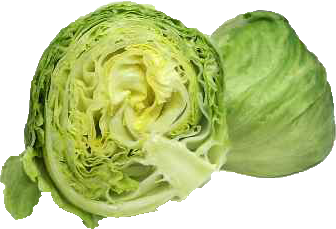|
Lettuce leaves
are the store house of many phyto-nutrients that have health promotional and
disease prevention properties.
Vitamins in
lettuce are plentiful. Fresh leaves are an excellent source of several Vitamin
A and beta carotenes. Just 100 g of fresh, raw-lettuce provides 247% of daily
vitamin A, and 4443 mcg of beta-carotene (Carotenes convert to vitamin A in the
body; 2 mcg of carotene is considered equivalent to 1 IU of vitamin A). These
compounds have antioxidant properties. Vitamin A is required for maintaining
healthy mucus membranes and skin, and is also essential for vision. Consumption
of natural fruits and vegetables rich in flavonoids helps to protect body from
lung and oral cavity cancers.
Zeaxanthin (1730
mcg per100) an important dietary carotenoid in lettuce is selectively absorbed
into the retinal macula lutea where it is thought to provide antioxidant and
protective light-filtering functions, thus it offers some protection against
age related macular disease (ARMD) in the elderly.
It is a rich
source of vitamin K, Vitamin K has potential role in the increase of bone mass
by promoting osteotrophic activity in the bone. It also has established role in
Alzheimer's disease patients by limiting neuronal damage in the brain.
Fresh leaves
contain good amounts folates and vitamin C. Folates require for DNA
synthesis and therefore, vital in prevention of neural tube defects in-utero
fetus during pregnancy. Vitamin C is a powerful natural antioxidant;
regular consumption of foods rich in vitamin C helps body develop resistance
against infectious agents and scavenge harmful, pro-inflammatory free radicals.
It also contain
good amounts of minerals like iron, calcium, magnesium, and potassium which are
very essential for body metabolism. Potassium in an important component of cell
and body fluids that helps controlling heart rate and blood pressure. Manganese
is used by the body as a co-factor for the antioxidant enzyme superoxide
dismutase. Copper is required in the production of red blood cells. Iron is
essential for red blood cell formation.
It is rich in
B-complex group of vitamins like thiamin, vitamin B-6 (pyridoxine),
riboflavins.
Regular inclusion
of lettuce in salads is known to prevent osteoporosis, iron deficiency anaemia
and believed to protect from cardiovascular diseases, ARMD, Alzheimer's disease
and cancers.
Anti-Inflammatory
Properties: Lettuce possesses anti-inflammatory
properties that help in controlling inflammation. In experimental models,
lettuce extracts have shown significant controlling power over inflammation
induced by biocatalysts like lipoxygenase and carrageenan.
Protects Neuronal
Cells: Neurons are brain cells that form physical connections to make up
memory. The death of neurons in particular connections or circuits can result
in the loss of memory. In some extreme cases, significant neuronal death can
result in the onset of diseases like Alzheimer’s. The extracts from lettuce
showed considerable control of neuron cell death due to its role in
glucose/serum deprivation (GSD). The research has also mentioned that lettuce
has the potential to be used in neuro-protection as a common remedy for
neurodegenerative diseases.
Lowers Cholesterol
Levels: Lettuce can be beneficial in lowering cholesterol levels that
often lead to cardiovascular disease and other dangerous conditions. High
cholesterol levels, particularly LDL or bad cholesterol levels, are harmful and
can cause heart attacks and strokes. A study was conducted on mice to test the
impact of lettuce consumption on fat and cholesterol. The results indicated a
significant reduction of cholesterol levels compared to mice that weren’t fed
lettuce. Lipid peroxidation was observed in most cases, which was concluded to
be responsible for important this form of cholesterol control.
Induces Sleep: One of the major traditional uses of lettuce in Unani medicine
was its use as a sleep inducer. Research into the extracts of lettuce resulted
in the isolation of a depressant chemical. This chemical, when administered in
experimental animals, showed significant sedative effects. Decreased heart rate
and ventricular contractions were also observed. This particular chemical acts
by blocking the excitatory signal processes of muscular and neural tissues.
Antioxidant
Properties: Studies have shown that lettuce possesses
antioxidants with significant free radical-scavenging capabilities.
Antioxidants are a wide range of bio-chemicals that are mostly found in our
diet; they are also very necessary for human health. Antioxidants act as
barriers to free radicals, which are produced during cellular metabolism. These
free radicals attack healthy tissues, cells and the DNA inside them. They can
often cause healthy cells to mutate into cancer cells. The result is the
development of various diseases. Antioxidants on the other hand, counteract
these free radicals and neutralize them before the free radical attacks take
place.
Antimicrobial
Properties: The latex of lettuce possesses antimicrobial
properties. Candida albicans and a number of other yeasts were completely
deformed upon coming into contact with the latex from lettuce. Bio chemicals
that are considered to possess these antimicrobial properties are the terpenes
and cardenolids, as well as enzymes like glucanases.
Controls Anxiety: The neurological properties of lettuce have long been suggested
and exploited during ancient times and the middle Ages in medical treaties such
as the Unani system. Detailed research in recent times has led to the
conclusion that lettuce possesses anxiolytic properties. When lab animals were
given lettuce extracts, their locomotive activity was reduced, suggesting
considerable anxiolytics.
Anti-Cancer
Properties: Lettuce leaf extracts can control certain
type of cancer. Research on human cancer cells, particularly leukaemia cells
and breast cancer cells, were controlled to a significant extent after being
treated with lettuce extracts. The experiments also suggested that the weight
ratio of human lettuce consumption required to kill 50% of leukaemia cells
would be 3 kg.
|

